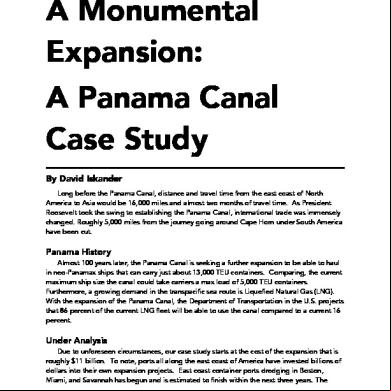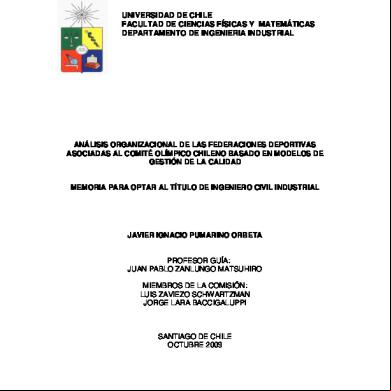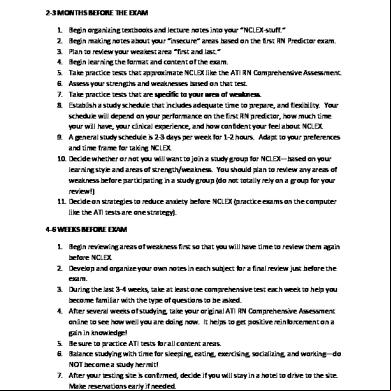A Panama Canal Case Study 37ve
This document was ed by and they confirmed that they have the permission to share it. If you are author or own the copyright of this book, please report to us by using this report form. Report 2z6p3t
Overview 5o1f4z
& View A Panama Canal Case Study as PDF for free.
More details 6z3438
- Words: 581
- Pages: 2
A Monumental Expansion: A Panama Canal Case Study By David Iskander Long before the Panama Canal, distance and travel time from the east coast of North America to Asia would be 16,000 miles and almost two months of travel time. As President Roosevelt took the swing to establishing the Panama Canal, international trade was immensely changed. Roughly 5,000 miles from the journey going around Cape Horn under South America have been cut.
Panama History
Almost 100 years later, the Panama Canal is seeking a further expansion to be able to haul in neo-Panamax ships that can carry just about 13,000 TEU containers. Comparing, the current maximum ship size the canal could take carriers a max load of 5,000 TEU containers. Furthermore, a growing demand in the transpacific sea route is Liquefied Natural Gas (LNG). With the expansion of the Panama Canal, the Department of Transportation in the U.S. projects that 86 percent of the current LNG fleet will be able to use the canal compared to a current 16 percent.
Under Analysis Due to unforeseen circumstances, our case study starts at the cost of the expansion that is roughly $11 billion. To note, ports all along the east coast of America have invested billions of dollars into their own expansion projects. East coast container ports dredging in Boston, Miami, and Savannah has begun and is estimated to finish within the next three years. The
2
projected inaugural of the expanded canal has been delayed numerous times due to increases in cost of construction with two European firms building the locks for the new canals. Many Fortune 500 companies will profit from this expansion. Including, Caterpillar with the use of its heavy machinery to build the canal, will be able to yield a profit from this expansion. Also, LNG companies like Phillips Conoco, BP, ExxonMobil, JV Hunt, and more will be able to take their East coast operations and ship them through the transpacific sea routes to Asia. Indeed, IBM will be able to yield a profit from the Panama Canal’s use of computer equipment to open and close the locks, help with logistics, and more. However, these are a bigger underlining issue with the canal’s expansion project. Recall that global GDP is at $60 trillion, $9 trillion dollars in products move across borders annually, and $1 trillion in services move across borders annually. In 2012, the Panama Canal recorded $2 billion in revenue from toll fees. Granted, global trade means global commerce with all possible routes of transportation. Yet, this seems to be quite an irrelevant expansion. While global GDP toppling over $60 trillion and the Panama Canal is deriving only $2 billion in revenue, their seems to be a lot more alternatives than the canal.
Other Factors Worth Considering Inclusively, there is one more important factor worth considering. A Chinese billionaire has set way to launch an almost $50 billion project to build a canal through Nicaragua. This 100 plus mile canal would be in direct competition with the Panamanian government. Lastly, a Black Swan hit just recently. As Russia annexed Crimea, gas demand in Europe is venerable from their suppliers in Russia as the EU stands against current Russian actions in Ukraine. Thus, a demand for LNG in Europe may be met with supply in North America. In all, the Panama Canal monumental expansion might just be left as a monument to an era of trade and sea route shipping through the transpacific route that quickly is dying away.
Panama History
Almost 100 years later, the Panama Canal is seeking a further expansion to be able to haul in neo-Panamax ships that can carry just about 13,000 TEU containers. Comparing, the current maximum ship size the canal could take carriers a max load of 5,000 TEU containers. Furthermore, a growing demand in the transpacific sea route is Liquefied Natural Gas (LNG). With the expansion of the Panama Canal, the Department of Transportation in the U.S. projects that 86 percent of the current LNG fleet will be able to use the canal compared to a current 16 percent.
Under Analysis Due to unforeseen circumstances, our case study starts at the cost of the expansion that is roughly $11 billion. To note, ports all along the east coast of America have invested billions of dollars into their own expansion projects. East coast container ports dredging in Boston, Miami, and Savannah has begun and is estimated to finish within the next three years. The
2
projected inaugural of the expanded canal has been delayed numerous times due to increases in cost of construction with two European firms building the locks for the new canals. Many Fortune 500 companies will profit from this expansion. Including, Caterpillar with the use of its heavy machinery to build the canal, will be able to yield a profit from this expansion. Also, LNG companies like Phillips Conoco, BP, ExxonMobil, JV Hunt, and more will be able to take their East coast operations and ship them through the transpacific sea routes to Asia. Indeed, IBM will be able to yield a profit from the Panama Canal’s use of computer equipment to open and close the locks, help with logistics, and more. However, these are a bigger underlining issue with the canal’s expansion project. Recall that global GDP is at $60 trillion, $9 trillion dollars in products move across borders annually, and $1 trillion in services move across borders annually. In 2012, the Panama Canal recorded $2 billion in revenue from toll fees. Granted, global trade means global commerce with all possible routes of transportation. Yet, this seems to be quite an irrelevant expansion. While global GDP toppling over $60 trillion and the Panama Canal is deriving only $2 billion in revenue, their seems to be a lot more alternatives than the canal.
Other Factors Worth Considering Inclusively, there is one more important factor worth considering. A Chinese billionaire has set way to launch an almost $50 billion project to build a canal through Nicaragua. This 100 plus mile canal would be in direct competition with the Panamanian government. Lastly, a Black Swan hit just recently. As Russia annexed Crimea, gas demand in Europe is venerable from their suppliers in Russia as the EU stands against current Russian actions in Ukraine. Thus, a demand for LNG in Europe may be met with supply in North America. In all, the Panama Canal monumental expansion might just be left as a monument to an era of trade and sea route shipping through the transpacific route that quickly is dying away.










